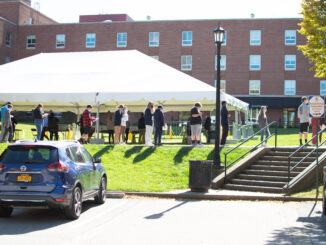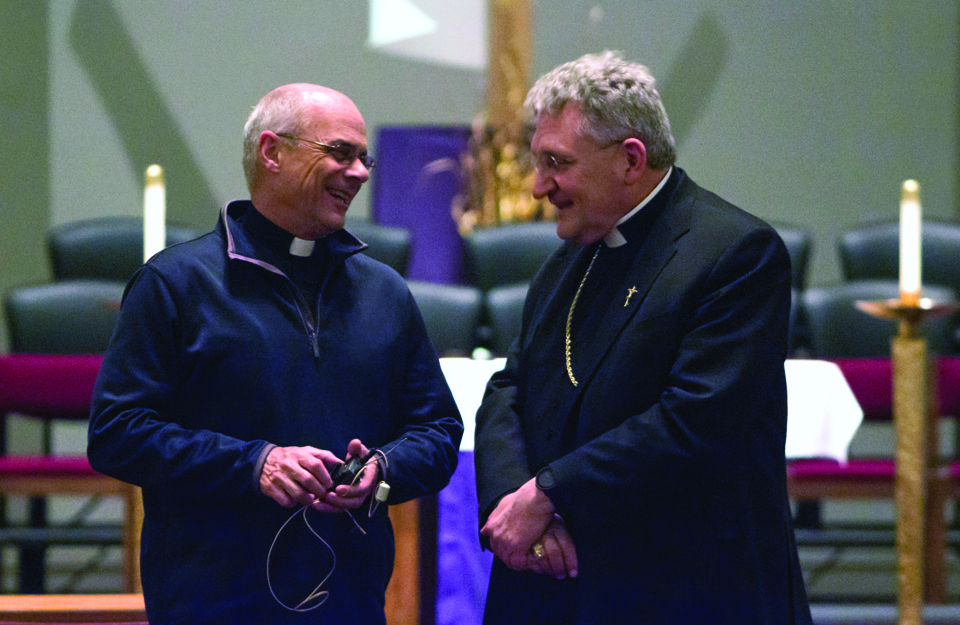
04/05/2018
Krystina Primack | Staff Writer
Since the early 1960s, Duquesne University has been the proud home of an extremely prominent and unique crucifix. What most students lovingly refer to as Scary Jesus is — according to the Duquesne University Times — actually officially given the title Crucifix, and is the creation of Austrian artist Jos Pirkner. The iconic piece has become one of the most recognizable fixtures on campus and brings with it an interesting history.
Pirkner, born in 1927, has spent the majority of his life as a sculptor and is still fairly well recognized for his work. Pirkner’s statues are often disproportionate and surreal depictions of otherwise common figures, as evidenced by the large crucifix statue on our campus.
The object itself is actually two combined pieces of work: the wooden cross which supports the Crucifix statue, and then the statue itself. Thomas White, adjunct instructor of history and university archivist said, “[Pirkner] constructed [Crucifix] in his studio in Holland, then it was sent here and mounted on the wooden cross.”
The statue altogether cost $6,000, and the artwork and the money to fund it was a gift from the Duquesne University Women’s Guild. According to Duquesne’s website, the group was founded in 1928 to work with the Dean of Women in sponsoring events and long-term projects. This organization remains active today working with the community to fundraise for various causes.
In the late 1950s, the Women’s Guild chose to fundraise in order to install a large crucifix on the campus, as there wasn’t one of that scale before. White explained, “What they used to do is pick a project every year, and focus on that for fundraising. And so in 1958 they raised the $6,000 … and then in 1960 [the statue] was brought to campus, installed and dedicated.”
Since then, the crucifix has gained quite a bit of notoriety. Namely, its appearance has caused many people to take a second glance, as the bronze depiction of Christ is very stylized, reflecting much of Pirkner’s work.
Pirkner chose to bring his own characterization to the statue, rather than adhering to other, more traditional interpretations. As a result, the piece has come to be known over the years as Scary Jesus. And although the exact origin of this particular nickname is unclear, the name has stuck regardless, due largely in part to the unique appearance of the piece.
Besides being visually unique, Crucifix has also managed to inspire its own unique campus legend. The most notable superstition to-date, according to White, originated in its former location.
“When [the crucifix] was where the ring statue [is], the legend always was that if you stepped in that circle of bricks before you took a test, you would fail.”
That certainly isn’t the most comforting information, and it’s somewhat unclear whether or not the tradition has been upheld by wary students, or if the legend has fallen by the wayside altogether.
“I’m not sure how that will go with the ring or not,” White said, “If it’ll continue about that spot, or move with the crucifix, or if now it’ll be both.”
Since the relocation happened three years ago, only time will answer those questions. As White said, sometimes these things take time to develop. “I’m sure in five or ten years it’ll be clear what the legend is.”
Until then that legend comes about, students at least know a little bit more about this aspect of Scary Jesus.
As briefly mentioned, the crucifix hasn’t always been in the location that we know today. Instead, it was once where the ring statue is now, and that was where it remained from its dedication in 1960 until a few years ago. The move was motivated by a few factors, including a necessary refurbishing of the bronze statue. During the process to separate the statue from its cross, it was discovered that the wood on the cross itself was beginning to rot.
“They needed to replace it, and they took [the statue to be] fixed up and cleaned. Then after, they had a new cross constructed,” White said.
From there, the crucifix was ready to be reinstalled. Although the decision to move the fixture instead of simply being put back in its original location is not clear, upon the return to campus it was placed and dedicated in its current home. Today, Crucifix stands between the Rockwell Hall skywalk entrance and the Rangos Health Sciences building.
Why it remains there as opposed to a more centralized location is another point of interest for many. Its original placement was essentially in the center of campus in the ’60s. To paint a brief picture, the landscape of the campus then consisted mainly of Canevin Hall, Rockwell Hall, Trinity Hall and Old Main. While the various projects to expand the campus were still underway, the area surrounding those buildings was essentially all of Duquesne.
“There used to be the rowhouses,” White explained as an example of Academic Walk’s previous landscape, “And the old library was a wing of the law school, which is now the law library. So when [Crucifix] was put in, it was kind of right in the center of campus.”
But since Duquesne’s portion of the Bluff has nearly tripled in size since the piece’s early days, the artwork now resides on the far end of campus.
Yet even located further away from the heart of the university than one might expect, Crucifix, or Scary Jesus, has been a significant part of our campus for more than 50 years. During that time, it has accumulated much interest and regard from its viewers. As a work of art, Scary Jesus has certainly taken on a life of its own, and deservedly so.




